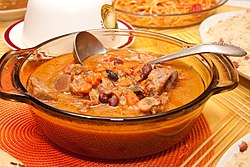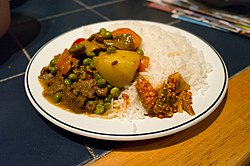  Top: Goat kaldereta; Bottom: Beef kaldereta with rice | |
| Course | Main course |
|---|---|
| Place of origin | The Philippines |
| Region or state | Popular in the Philippines, Luzon (Southern Tagalog) |
| Serving temperature | Hot |
| Main ingredients | Goat /mutton shoulders, corn oil, onion, garlic, carrots, bell pepper, potatoes, chili, flour, liver spread, tomato paste, butter, stock (beef or brown) |
| Variations | Beef, pork, chicken |
| Similar dishes | Afritada, menudo |
Kaldereta or caldereta [1] [2] is a goat meat [3] stew from the Philippines. Variations of the dish use beef, [4] chicken, [5] or pork. Commonly the goat meat is stewed with vegetables and liver paste. The vegetables may include tomatoes, potatoes, olives, bell peppers, and hot peppers. Kaldereta sometimes includes tomato sauce. Kaldereta is usually served during special occasions such as parties and festivities.
Contents
Kaldereta's name derives from the Spanish word caldera, the original, Spanish dish the Filipino version comes directly from. The caldereta tradition in the Iberian Peninsula is prepared in two variations, fish and goat, so the Filipino version probably emerged from recreating the original recipe using local ingredients.
It also has similarities with afritada and mechado because it uses tomatoes, potatoes, carrots, and bell peppers as its main ingredients.


